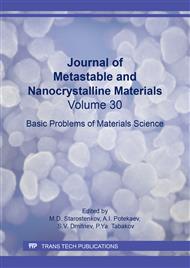[1]
E.A. Shur, Rail Damage, Intekst, Moscow, (2012).
Google Scholar
[2]
V.E. Gromov, A.B. Yur'ev, K.V. Morozov, Yu.F. Ivanov, Microstructure of Hardened Rails, Inter-Kuzbass, Novokuznetsk, (2014).
Google Scholar
[3]
Yu. Ivanisenko, H.J. Fecht, Microstructure modification in the surface layers of railway rails and wheels: effect of high strain rate deformation, Steel tech. 3 (2008) 19-23.
Google Scholar
[4]
Yu. Ivanisenko, I. MacLaren, X. Sauvage, R. Z Valiev., H. -J. Fecht, Shear-induced α→γ transformation in nanoscale Fe-C composite, Acta Mater. 54 (2006) 1659-1669.
DOI: 10.1016/j.actamat.2005.11.034
Google Scholar
[5]
Jiang-li Ning, E. Courtois-Manara, L. Kurmanaeva, A.V. Ganeev, R.Z. Valiev, C. Kübel, Yu. Ivanisenko, Tensile properties and work hardening behaviors of ultrafine grained carbon steel and pure iron processed by warm high pressure torsion, Materials Science and Engineering: A, 581 (2013).
DOI: 10.1016/j.msea.2013.05.008
Google Scholar
[6]
V.G. Gavriljuk, Decomposition of cementite in pearlitic steel due to plastic deformation, Materials Science and Engineering: A, 345 (2003) 81-89.
DOI: 10.1016/s0921-5093(02)00358-1
Google Scholar
[7]
Y.J. Li, P. Chai, C. Bochers, S. Westerkamp, S. Goto, D. Raabe, R. Kirchheim, Atomic-scale mechanisms of deformation-induced cementite decomposition in pearlite, Acta Mater. 59 (2011) 3965–3977.
DOI: 10.1016/j.actamat.2011.03.022
Google Scholar
[8]
V.G. Gavriljuk, Comment on Effect of interlamellar spacing on cementite dissolution during wire drawing of pearlitic steel wires, Scripta Materialia, 45 (2001) 1469-1472.
DOI: 10.1016/s1359-6462(01)01185-x
Google Scholar
[9]
A.M. Glezer, The nature of ultrahigh plastic (megaplastic) deformation, Bull. Russ. Acad. Sci.: Phys. 71 (2007) 1722.
DOI: 10.3103/s106287380712012x
Google Scholar
[10]
V.E. Gromov, E.V. Kozlov, V.I. Bazaikin et al., Physics and mechanics of drawing and forging, Nedra, Moscow, (1997).
Google Scholar
[11]
G. Thomas and M.J. Goringe, Transmission electron microscopy of materials, Wiley, New York, (1979).
Google Scholar
[12]
P.B. Hirsch, A. Howie, R.B. Nicholson, D.W. Pashley, and M.J. Whelan, Electron microscopy of thin crystals, Butterworth, Washington, (1965).
Google Scholar
[13]
L.M. Utevskii, Diffraction electron microscopy in metallography, Metallurgiya, Moscow, (1973).
Google Scholar
[14]
Yu.F. Ivanov, V.E. Gromov, O.A. Peregudov, K.V. Morozov, A.B. Yur'ev, Evolution of the structure and phase states of rails in prolonged operation, Steel in translation, 45 (2015) 254-257.
DOI: 10.3103/s0967091215040075
Google Scholar
[15]
O.A. Peregudov, V.E. Gromov, Yu.F. Ivanov, K.V. Morozov, K.V. Alsaraeva, O.A. Semina, Structure-phase states evolution in rails during a long operation, AIP conference proceedings, 1683 (2015) 020179.
DOI: 10.1063/1.4932869
Google Scholar
[16]
Yu.F. Ivanov, O.A. Peregudov, K.V. Morozov, V.E. Gromov, N.A. Popova, E.N. Nikonenko, Formation structural phase gradients in rail steel during long-term operation, IOP Conference Series: Materials Science and Engineering, 112 (2016) 012038.
DOI: 10.1088/1757-899x/112/1/012038
Google Scholar
[17]
V.E. Gromov, O.A. Peregudov, Y.F. Ivanov, A.M. Glezer, K.V. Morozov, K.V. Aksenova, O.A. Semina, Physical nature of rail strengthening in long term operation, AIP Conference Proceedings, 1783 (2016) 020069.
DOI: 10.1063/1.4966362
Google Scholar
[18]
Yu.F. Ivanov, O.A. Peregudov, K.V. Morozov, V.E. Gromov, N.A. Popova, E.N. Nikonenko, Formation structural phase gradients in rail steel during long-term operation, IOP Conference Series: Materials Science and Engineering, 112 (2016). 012038.
DOI: 10.1088/1757-899x/112/1/012038
Google Scholar
[19]
O.A. Peregudov, V.E. Gromov, Y.F. Ivanov, K.V. Morozov, S.V. Konovalov, Structural and phase states in high-quality rail, Steel in translation, 46 (2016) 260-263.
DOI: 10.3103/s0967091216040100
Google Scholar
[20]
O.A. Peregudov, K.V. Morozov, V.E. Gromov, A.M. Glezer, Yu.F. Ivanov, Formation of internal stress fields in rails during long-term operation, Russian metallurgy, 2016 (2016) 371-374.
DOI: 10.1134/s0036029516040182
Google Scholar
[21]
V.E. Gromov, Y.F. Ivanov, K.V. Morozov, O.A. Peregudov, O.A. Semina, Long-term operation of rail steel: degradation of structure and properties of surface layer, Journal of surface investigation. X-ray, Synchrotron and Neytron techniques, 10 (2016).
DOI: 10.1134/s1027451016050281
Google Scholar


